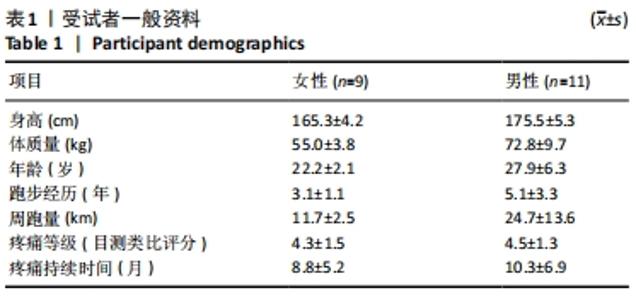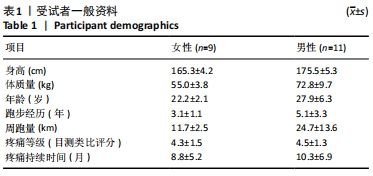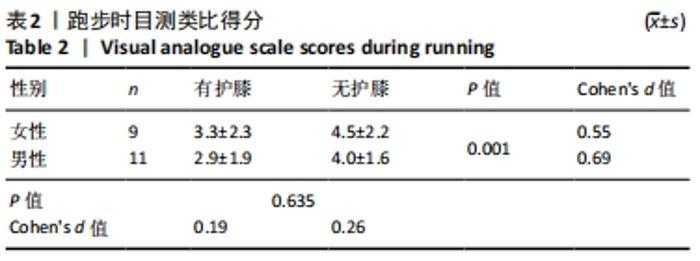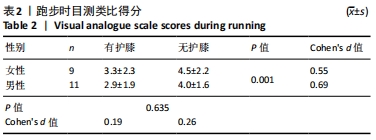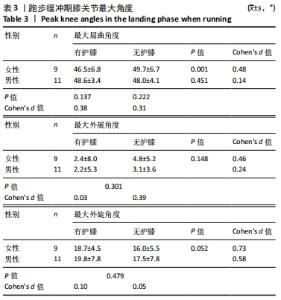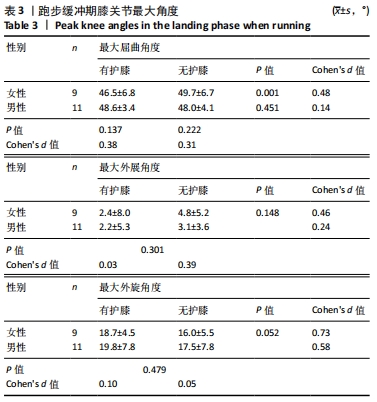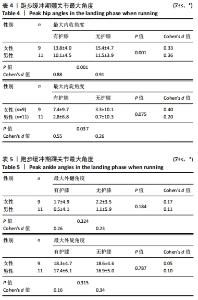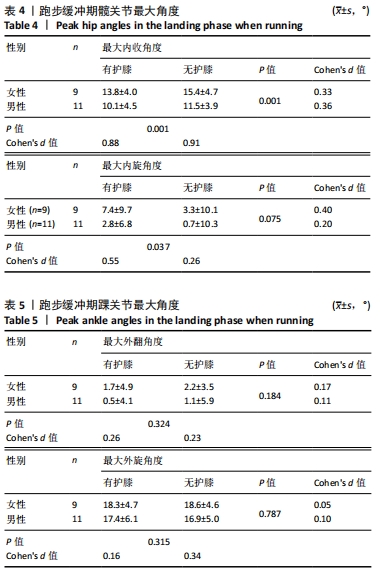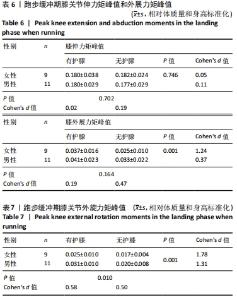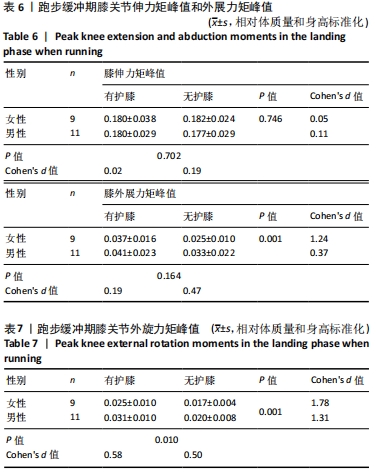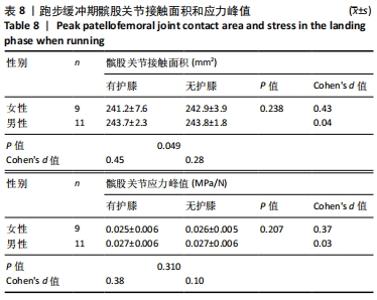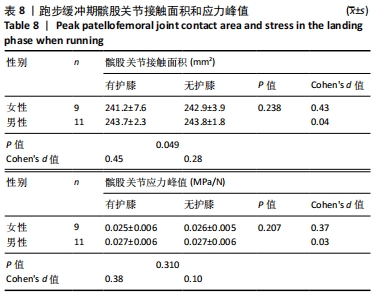Chinese Journal of Tissue Engineering Research ›› 2022, Vol. 26 ›› Issue (17): 2749-2755.doi: 10.12307/2022.546
Previous Articles Next Articles
Effects of knee sleeve on perceived pain and lower extremity kinematics and kinetics in male and female runners with patellofemoral pain
Yang Chen1, Feng Ru1, Zhou Zhipeng2, Wan Xianglin3, Qu Feng3
- 1School of Sports and Health, Nanjing Sport Institute, Nanjing 210014, Jiangsu Province, China; 2School of Sports and Health, Shandong Sport University, Jinan 250102, Shandong Province, China; 3School of Sports and Human Sciences, Beijing Sport University, Beijing 100084, China
-
Received:2021-03-04Revised:2021-03-06Accepted:2021-04-10Online:2022-06-18Published:2021-12-27 -
About author:Yang Chen, PhD, Lecturer, School of Sports and Health, Nanjing Sport Institute, Nanjing 210014, Jiangsu Province, China -
Supported by:the Natural Science Foundation of Jiangsu Provincial Higher Education Institutions of China (General Program), No. 9KJB32000 (to YC); the Cultivation Project of Nanjing Sport Institute, No. PY202012 (to YC)
CLC Number:
Cite this article
Yang Chen, Feng Ru, Zhou Zhipeng, Wan Xianglin, Qu Feng. Effects of knee sleeve on perceived pain and lower extremity kinematics and kinetics in male and female runners with patellofemoral pain[J]. Chinese Journal of Tissue Engineering Research, 2022, 26(17): 2749-2755.
share this article
Add to citation manager EndNote|Reference Manager|ProCite|BibTeX|RefWorks
| [1] NEAL BS, LACK SD, LANKHORST NE, et al. Risk factors for patellofemoral pain: a systematic review and meta-analysis. Br J Sports Med. 2019; 53(5):270-281. [2] CROSSLEY KM, VAN MIDDELKOOP M, BARTON CJ, et al. Rethinking patellofemoral pain: Prevention, management and long-term consequences. Best Pract Res Clin Rheumatol. 2019;33(1):48-65. [3] LANKHORST NE, VAN MIDDELKOOP M, CROSSLEY KM, et al. Factors that predict a poor outcome 5-8 years after the diagnosis of patellofemoral pain: a multicentre observational analysis.Br J Sports Med. 2016;50(14): 881-886. [4] UTTING MR, DAVIES G, NEWMAN JH. Is anterior knee pain a predisposing factor to patellofemoral osteoarthritis?. The Knee.2005;12(5):362-365. [5] SALTYCHEV M, DUTTON R, LAIMI K, et al. Effectiveness of conservative treatment for patellofemoral pain syndrome: A systematic review and meta-analysis. J Rehabil Med. 2018;50(5):393-401. [6] POWERS CM, WITVROUW E, DAVIS IS, et al. Evidence-based framework for a pathomechanical model of patellofemoral pain: 2017 patellofemoral pain consensus statement from the 4th International Patellofemoral Pain Research Retreat, Manchester, UK: part 3. Br J Sports Med. 2017; 51(24):1713-1723. [7] 杨辰, 曲峰. 髌股关节痛病因、治疗和分组的生物力学研究进展[J]. 中国运动医学杂志,2017,36(10):927-932. [8] CULVENOR AG, VAN MIDDELKOOP M, MACRI EM, et al. Is patellofemoral pain preventable? A systematic review and meta-analysis of randomised controlled trials.Br J Sports Med. 2020:bjsports-2020-102973. [9] SELFE J, CALLAGHAN M, WITVROUW E, et al. Targeted interventions for patellofemoral pain syndrome (TIPPS): classification of clinical subgroups. BMJ Open.2013;3(9):e3795. [10] EARL-BOEHM JE, BOLGLA LA, EMORY C, et al. Treatment Success of Hip and Core or Knee Strengthening for Patellofemoral Pain: Development of Clinical Prediction Rules.J Athl Train. 2018;53(6):545-552. [11] CHEW KT, LEW HL, DATE E,et al. Current Evidence and Clinical Applications of Therapeutic Knee Braces. Am J Phys Med Rehabil. 2007; 86(8):678-686. [12] POWERS CM, WARD SR, CHEN YJ, et al. The effect of bracing on patellofemoral joint stress during free and fast walking.Am J Sports Med. 2004;32(1):224-231. [13] KÖLLE T, ALT W, WAGNER D. Immediate effects of an elastic patellar brace on pain, neuromuscular activity and knee kinematics in subjects with patellofemoral pain. Arch Orthop Trauma Surg. 2020;140(7):905-912. [14] SINCLAIR JK, SELFE J, TAYLOR PJ, et al. Influence of a knee brace intervention on perceived pain and patellofemoral loading in recreational athletes.Clin Biomech (Bristol, Avon). 2016;37:7-12. [15] D’HONDT NE, STRUIJS PA, KERKHOFFS GM, et al. Orthotic devices for treating patellofemoral pain syndrome. Cochrane Database Syst Rev. 2002;(2):CD002267. [16] POWERS CM. The influence of altered lower-extremity kinematics on patellofemoral joint dysfunction: a theoretical perspective.J Orthop Sports Phys Ther. 2003;33(11):639-646. [17] COLLINS NJ, BARTON CJ, VAN MIDDELKOOP M, et al. 2018 Consensus statement on exercise therapy and physical interventions (orthoses, taping and manual therapy) to treat patellofemoral pain: recommendations from the 5th International Patellofemoral Pain Research Retreat, Gold Coast, Australia, 2017. Br J Sports Med. 2018; 52(18):1170-1178. [18] WILLY RW, MANAL KT, WITVROUW EE, et al. Are Mechanics different between male and female runners with patellofemoral pain?. Med Sci Sports Exerc. 2012;44(11):2165-2171. [19] Ruland JR, III MMH, Diduch DR. Patellofemoral Pain: Current Concepts. Annals of Sports Medicine and Research.2017;5(4):1118-1121. [20] ESCULIER J, ROY J, BOUYER LJ. Lower limb control and strength in runners with and without patellofemoral pain syndrome. Gait Posture. 2015; 41(3):813-819. [21] Bazett-Jones DM, Huddleston W, Cobb S, et al. Acute Responses of Strength and Running Mechanics to Increasing and Decreasing Pain in Patients With Patellofemoral Pain. J Athl Train. 2017;52(5):411-421. [22] Bell AL, Brand RA, Pedersen DR. Prediction of hip joint centre location from external landmarks. Human Movement Science. 1989;8(1):3-16. [23] WU G, SIEGLER S, ALLARD P, et al.ISB recommendation on definitions of joint coordinate system of various joints for the reporting of human joint motion--part I: ankle, hip, and spine. International Society of Biomechanics. J Biomech. 2002;35(4):543-548. [24] GREENWOOD DT. Principles of dynamics. Prentice-Hall Englewood Cliffs. NJ.1988. [25] 刘卉, 张美珍, 李翰君, 等. 足球运动员在急停起跳和侧切动作中前交叉韧带损伤的生物力学特征研究[J]. 体育科学,2011,31(12):38-43. [26] NUNES GS, SILVA RS, SANTOS AFD, et al. Methods to assess patellofemoral joint stress: a systematic review. Gait Posture. 2018;61:188-196. [27] ARAZPOUR M, NOTARKI TT, SALIMI A, et al. The effect of patellofemoral bracing on walking in individuals with patellofemoral pain syndrome. Prosthet Orthot Int. 2013;37(6):465-470. [28] DRAPER CE, BESIER TF, SANTOS JM, et al. Using real-time MRI to quantify altered joint kinematics in subjects with patellofemoral pain and to evaluate the effects of a patellar brace or sleeve on joint motion.J Orthop Res. 2009;27(5):571-577. [29] SHERMAN SL, PLACKIS AC, NUELLE CW. Patellofemoral Anatomy and Biomechanics. Clin Sports Med. 2014;33(3):389-401. [30] WALSH M, BOLING MC, MCGRATH M, et al. Lower Extremity Muscle Activation and Knee Flexion During a Jump-Landing Task. J Athl Train. 2012;47(4):406-413. [31] HUBERTI HH, HAYES WC. Patellofemoral contact pressures. The influence of q-angle and tendofemoral contact. J Bone Joint Surg Am. 1984;66(5): 715-724. [32] NOEHREN B, SCHOLZ J, DAVIS I. The effect of real-time gait retraining on hip kinematics, pain and function in subjects with patellofemoral pain syndrome. Br J Sports Med. 2011;45(9):691-696. [33] SALSICH GB, BRECHTER JH, POWERS CM. Lower extremity kinetics during stair ambulation in patients with and without patellofemoral pain. Clin Biomech (Bristol, Avon). 2001;16(10):906-912. [34] CALLAGHAN MJ, PARKES MJ, HUTCHINSON CE, et al. Factors associated with arthrogenous muscle inhibition in patellofemoral osteoarthritis. Osteoarthritis Cartilage. 2014;22(6):742-746. [35] HENRIKSEN M, ROSAGER S, AABOE J, et al. Experimental Knee Pain Reduces Muscle Strength. J Pain. 2011;12(4):460-467. [36] SEELEY MK, PARK J, KING D, et al. A Novel Experimental Knee-Pain Model Affects Perceived Pain and Movement Biomechanics. J Athl Train. 2013; 48(3):337-345. [37] GREUEL H, HERRINGTON L, LIU A, et al. How does acute pain influence biomechanics and quadriceps function in individuals with patellofemoral pain?. Knee. 2019;26(2):330-338. [38] HENRIKSEN M, SIMONSEN EB, ALKJÆR T, et al. Increased joint loads during walking – A consequence of pain relief in knee osteoarthritis. Knee. 2006;13(6):445-450. [39] BONACCI J, VICENZINO B, SPRATFORD W, et al. Take your shoes off to reduce patellofemoral joint stress during running. Br J Sports Med. 2014; 48(6):425-428. [40] SINCLAIR J, SELFE J. Sex differences in knee loading in recreational runners. J Biomech. 2015;48(10):2171-2175. [41] STEFANYSHYN DJ, STERGIOU P, LUN VM, et al. Knee angular impulse as a predictor of patellofemoral pain in runners. Am J Sports Med. 2006; 34(11):1844-1851. |
| [1] | Tan Xinfang, Guo Yanxing, Qin Xiaofei, Zhang Binqing, Zhao Dongliang, Pan Kunkun, Li Yuzhuo, Chen Haoyu. Effect of uniaxial fatigue exercise on patellofemoral cartilage injury in a rabbit [J]. Chinese Journal of Tissue Engineering Research, 2022, 26(在线): 1-6. |
| [2] | Li Jie, Zhang Haitao, Chen Jinlun, Ye Pengcheng, Zhang Hua, Zhou Bengen, Zhao Changqing, Sun Youqiang, Chen Jianfa, Xiang Xiaobing, Zeng Yirong. Anterior cruciate ligament rupture and patellofemoral joint stability before sagittal and axial measurement using MRI [J]. Chinese Journal of Tissue Engineering Research, 2022, 26(6): 969-972. |
| [3] | Huang Hao, Hong Song, Wa Qingde. Finite element analysis of the effect of femoral component rotation on patellofemoral joint contact pressure in total knee arthroplasty [J]. Chinese Journal of Tissue Engineering Research, 2022, 26(6): 848-852. |
| [4] | Tan Xinfang, Guo Yanxing, Qin Xiaofei, Zhang Binqing, Zhao Dongliang, Pan Kunkun, Li Yuzhuo, Chen Haoyu. Effect of uniaxial fatigue exercise on patellofemoral cartilage injury in a rabbit [J]. Chinese Journal of Tissue Engineering Research, 2022, 26(14): 2184-2189. |
| [5] | Ouyang Yiyi, Peng Jie, Wang Kun, Zhang Tingran, Luo Jiong. Changes in biomechanical characteristics of children’s lower limbs during visual deprivation and dual tasks [J]. Chinese Journal of Tissue Engineering Research, 2022, 26(12): 1834-1842. |
| [6] | Han Mingzhan, Maihemuti·Yakufu, Chen Hongtao, Liu Jianjiang, Abudusufu·Kuwan, Aierken·Amudong. Patellar suture anchors and semi-tunneling polyetheretherketone suture anchors for double-bundle reconstruction of medial patellofemoral ligament [J]. Chinese Journal of Tissue Engineering Research, 2022, 26(12): 1854-1860. |
| [7] | Xu Jie, Zhou Wenqi, Luo Xiaobing. Visual analysis of patellofemoral pain syndrome research hotspots and content [J]. Chinese Journal of Tissue Engineering Research, 2022, 26(12): 1877-1887. |
| [8] | Shang Wandi, Wang Xingze, Wei Xiaoyan. Effects of different types of abdominal support on lumbar-back muscle surface electromyography signals in people with abdominal obesity [J]. Chinese Journal of Tissue Engineering Research, 2022, 26(11): 1656-1661. |
| [9] | Liu Zhichao, Zhang Fan, Sun Qi, Kang Xiaole, Yuan Qiaomei, Liu Genzhe, Chen Jiang. Morphology and activity of human nucleus pulposus cells under different hydrostatic pressures [J]. Chinese Journal of Tissue Engineering Research, 2021, 25(8): 1172-1176. |
| [10] | Ji Zhongqiu, Li Jiahui, Zhao Panchao, Jiang Guiping. Biomechanical characteristics of children with different body weights during vertical jump [J]. Chinese Journal of Tissue Engineering Research, 2021, 25(33): 5281-5287. |
| [11] | Zhou Wenxing, Wang Lin . Effect of side cutting foot strike pattern and angle on the biomechanics of lower extremities [J]. Chinese Journal of Tissue Engineering Research, 2021, 25(32): 5184-5190. |
| [12] | Chen Xiaolong, Zhao Heng, Hu Rong, Luo Guanghua, Liu Jincai . Correlation of infrapatellar fat pad edema with trochlear and patellofemoral joint morphology: MRI evaluation [J]. Chinese Journal of Tissue Engineering Research, 2021, 25(15): 2410-2415. |
| [13] | Li Shanghua, Wang Haiyan. Biomechanics of lower extremities from straight forward to side-step cutting [J]. Chinese Journal of Tissue Engineering Research, 2020, 24(8): 1260-1266. |
| [14] | Lin Yuan, Xu Bin, Tu Jun, Xu Honggang, Guo Ruipeng. Effect of different femoral tunnel locations on patellofemoral joint during single-bundle anterior cruciate ligament reconstruction [J]. Chinese Journal of Tissue Engineering Research, 2020, 24(14): 2140-2146. |
| [15] | Liu Xin, Xiang Chuan. Causes and treatment strategies of anterior knee pain after total knee arthroplasty [J]. Chinese Journal of Tissue Engineering Research, 2019, 23(20): 3213-3219. |
| Viewed | ||||||
|
Full text |
|
|||||
|
Abstract |
|
|||||
